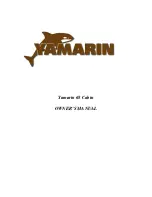
16. GETTING READY TO POWER / POWER MODE
40
System Check Operation
1.
Attach emergency stop lanyard.
2.
Turn key switch to ON.
3.
Observe the System Check self-test function.
Warning horn should sound for ½ second and all
warning lights should turn on at the same time
then turn off one at a time.
Fuel System
1.
Squeeze fuel primer bulb until hard. Observe all
fuel hoses and connections. Repair any leaks.
2.
Start outboard. Inspect all hoses and connections.
Repair any leaks or misrouted hoses immediately
Emergency Stop / Key Switch
Check emergency stop function. With outboard
running at idle, pull safety lanyard from emergency
stop switch. Outboard should stop immediately.
Remote Control Operation
Make sure the control can be easily moved into all
gear and throttle settings. Do not shift remote control
when outboard is not running.
Start-in-Gear Prevention
Please follow the manufacturer’s manual for
performing this “Starter-in-Gear Prevention”
procedure
.
SAFETY HAZARD
Make certain that the starter will not operate
when the outboard is in gear. The starter-in
gear prevention feature is required by the
United State Coast Guard to help prevent
personal injuries.
Tachometer Pulse Setting
1.
Confirm accuracy of tachometer reading.
2.
Adjust dial on back of tachometer to required
setting (the outboard should not be running).
3.
Refer to outboard engine manual for settings of
tachometer of particular outboard model.
Water Pump Overboard Indicator
A steady stream of water should flow from the
overboard indicator.
Operating Temperature
An outboard running at idle speed should achieve a
temperature based on the engine’s thermostatic
control. In general, the powerhead temperature
should reach at least 104
°
F ( 40
°
C) after five minutes
of idling. Check that the powerhead reaches idle
temperature.
Idle Speed
Outboard idle speed is essential for proper outboard
control and shift function. Make sure the outboard
idles within the specified idle RPM range. If the
outboard is run on a flushing device, the idle and
quality may not be representative of actual “in water”
use.
Break-In
Please refer to the correct break-in procedure in the
manufacturer’s manual.
Warm-up
Before cruising, run the engine at a low speed for
about three minutes as a warm-up operation to allow
the oil to circulate throughout the machine. Otherwise,
the life of the engine will be negatively affected.
During warm-up operation, confirm that cooling water
is discharged from its check port.
Fueling
When fueling your engine, be sure to use fresh fuel.
Fuel that has been in a tank too long can form gum
and varnish, which can affect performance. Use oil as
recommended by the manufacturer. Two stroke
engines require a special oil to be either mixed with
gasoline or injected from a remote tank. This
lubrication is essential for the operation of the engine.
EXPLOSION/FIRE HAZARD
•
Store flammable material in safety approved
containers. Keep containers in an area
designed for that purpose. Never store in a
non-vented space.
•
Observe no-smoking while fueling
•
Fill to less than the capacity of the tank.
Allow for fuel expansion.
•
Inspect fuel system regularly for leaks.
Summary of Contents for 27 the EDGE
Page 1: ...Operator s Manual 27 27 the EDGE the EDGE ...
Page 2: ......
Page 60: ......
Page 64: ......
Page 65: ......
Page 66: ......
Page 68: ......
Page 69: ......
Page 70: ......
Page 71: ......
Page 72: ......
Page 74: ......
Page 75: ......
Page 76: ......
Page 77: ......
Page 78: ......
Page 79: ......
Page 80: ......
Page 81: ......
Page 82: ......
Page 83: ......
Page 84: ......
Page 85: ......
Page 86: ......
Page 87: ......
Page 88: ......
Page 89: ......
Page 91: ......
















































